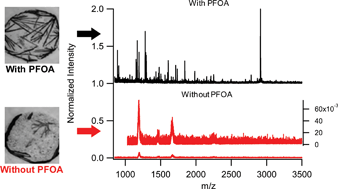Fluorinated liquid-enabled protein handling and surfactant-aided crystallization for fully in situ digital microfluidic MALDI-MS analysis†
Abstract
A droplet (digital) microfluidic device has been developed that enables complete

* Corresponding authors
a Biomedical Engineering Interdepartmental PhD Program, University of California, Los Angeles, CA, USA
b Department of Chemistry and Biochemistry, University of California, Los Angeles, CA, USA
c
California NanoSystems Institute (CNSI), University of California, Los Angeles, CA, USA.
E-mail:
garrell@chem.ucla.edu
Tel: +1 310-825-4383
A droplet (digital) microfluidic device has been developed that enables complete

 Please wait while we load your content...
Something went wrong. Try again?
Please wait while we load your content...
Something went wrong. Try again?
A. P. Aijian, D. Chatterjee and R. L. Garrell, Lab Chip, 2012, 12, 2552 DOI: 10.1039/C2LC21135A
To request permission to reproduce material from this article, please go to the Copyright Clearance Center request page.
If you are an author contributing to an RSC publication, you do not need to request permission provided correct acknowledgement is given.
If you are the author of this article, you do not need to request permission to reproduce figures and diagrams provided correct acknowledgement is given. If you want to reproduce the whole article in a third-party publication (excluding your thesis/dissertation for which permission is not required) please go to the Copyright Clearance Center request page.
Read more about how to correctly acknowledge RSC content.
 Fetching data from CrossRef.
Fetching data from CrossRef.
This may take some time to load.
Loading related content
